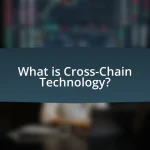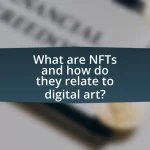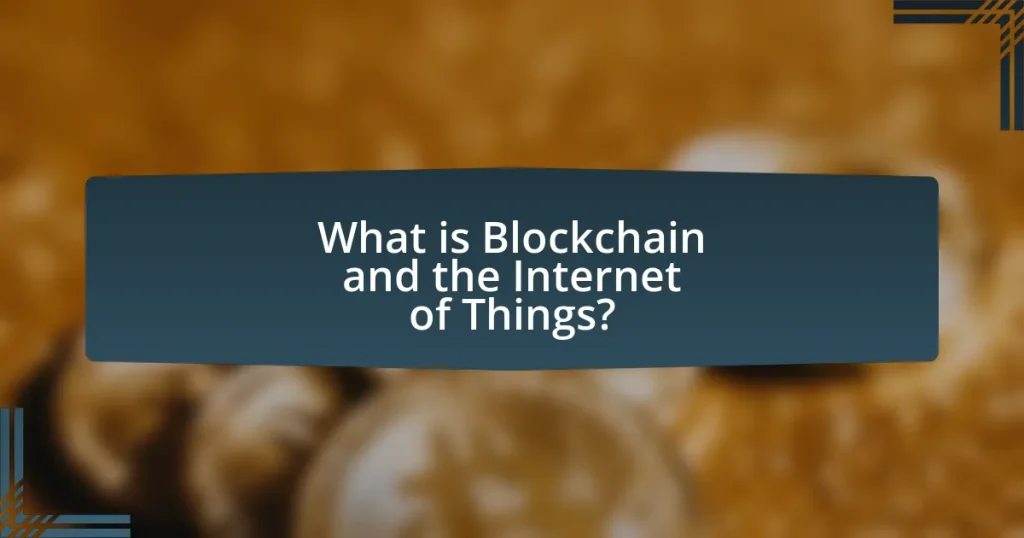Blockchain and the Internet of Things (IoT) represent a transformative combination that enhances security, transparency, and efficiency in data exchange among interconnected devices. This article explores the interaction between these technologies, highlighting how blockchain’s decentralized ledger can secure IoT applications, improve supply chain management, and facilitate smart city initiatives. Key features of blockchain, such as immutability and consensus mechanisms, are examined alongside the fundamental principles of IoT, including connectivity and automation. Additionally, the article addresses the challenges of integrating blockchain with IoT, such as scalability and regulatory compliance, while outlining future trends and best practices for successful implementation.

What is Blockchain and the Internet of Things?
Blockchain is a decentralized digital ledger technology that securely records transactions across multiple computers, ensuring that the recorded data cannot be altered retroactively. The Internet of Things (IoT) refers to the network of interconnected devices that communicate and exchange data over the internet. Together, blockchain and IoT create a framework for secure data sharing and automation, enhancing the reliability and efficiency of IoT systems. For instance, a study by IBM highlights that integrating blockchain with IoT can improve supply chain transparency and security, as each device can verify transactions independently, reducing the risk of fraud and data tampering.
How do Blockchain and the Internet of Things interact?
Blockchain and the Internet of Things (IoT) interact by enhancing security, transparency, and efficiency in data exchange among connected devices. Blockchain provides a decentralized ledger that records transactions securely, ensuring that data from IoT devices is tamper-proof and verifiable. For instance, in supply chain management, IoT sensors can track products, while blockchain can authenticate and log each transaction, reducing fraud and errors. This integration allows for real-time monitoring and automated processes through smart contracts, which execute actions based on predefined conditions. The combination of these technologies addresses vulnerabilities in IoT networks, as blockchain’s cryptographic features protect against unauthorized access and data manipulation.
What are the key features of Blockchain technology?
The key features of Blockchain technology include decentralization, transparency, security, immutability, and consensus mechanisms. Decentralization allows data to be stored across a network of computers, reducing the risk of a single point of failure. Transparency ensures that all transactions are visible to participants, fostering trust among users. Security is enhanced through cryptographic techniques that protect data from unauthorized access. Immutability means that once data is recorded on the blockchain, it cannot be altered or deleted, ensuring the integrity of the information. Lastly, consensus mechanisms, such as Proof of Work or Proof of Stake, validate transactions and maintain the network’s integrity by requiring agreement among participants before changes are made. These features collectively contribute to the reliability and efficiency of blockchain applications.
What are the fundamental principles of the Internet of Things?
The fundamental principles of the Internet of Things (IoT) include connectivity, data collection, automation, and interoperability. Connectivity allows devices to communicate over the internet, enabling real-time data exchange. Data collection involves gathering information from various sensors and devices, which is essential for analysis and decision-making. Automation refers to the ability of IoT systems to perform tasks without human intervention, enhancing efficiency and responsiveness. Interoperability ensures that different devices and systems can work together seamlessly, facilitating a cohesive ecosystem. These principles are critical for the effective functioning of IoT applications across various industries, such as smart homes, healthcare, and industrial automation.
Why is the combination of Blockchain and the Internet of Things significant?
The combination of Blockchain and the Internet of Things (IoT) is significant because it enhances security, transparency, and efficiency in data exchange among connected devices. Blockchain provides a decentralized and immutable ledger that ensures data integrity, which is crucial for IoT applications where devices communicate autonomously. For instance, a study by IBM and the Institute for Business Value found that 79% of organizations believe that blockchain will be critical for IoT security. This integration allows for secure transactions and automated processes, reducing the risk of data breaches and fraud while enabling real-time monitoring and control of IoT devices.
What challenges do IoT systems face that Blockchain can address?
IoT systems face challenges such as security vulnerabilities, data integrity issues, and lack of interoperability, which blockchain technology can effectively address. Blockchain enhances security by providing a decentralized and tamper-proof ledger, making it difficult for unauthorized parties to alter data. For instance, a study by IBM highlights that blockchain can secure IoT devices against cyberattacks by ensuring that only authenticated devices can communicate on the network. Additionally, blockchain ensures data integrity through cryptographic hashing, which verifies that data has not been altered during transmission. Furthermore, blockchain facilitates interoperability among diverse IoT devices by providing a standardized protocol for communication, as evidenced by research from the IEEE, which emphasizes the potential of blockchain to unify various IoT ecosystems.
How does Blockchain enhance security in IoT applications?
Blockchain enhances security in IoT applications by providing a decentralized and immutable ledger that ensures data integrity and authenticity. This technology allows devices to communicate securely without relying on a central authority, reducing the risk of single points of failure and potential cyberattacks. For instance, the use of cryptographic techniques in blockchain ensures that data transmitted between IoT devices is encrypted and tamper-proof, making it difficult for unauthorized parties to alter or intercept the information. Additionally, smart contracts can automate and enforce security protocols, further enhancing the overall security framework of IoT ecosystems.

What are the practical applications of Blockchain in IoT?
Blockchain technology has practical applications in IoT primarily through enhancing security, improving data integrity, and enabling decentralized device management. By utilizing blockchain, IoT devices can securely share data without the need for a central authority, reducing the risk of data breaches. For instance, in supply chain management, blockchain can track the provenance of goods, ensuring transparency and authenticity. Additionally, smart contracts on blockchain can automate processes between IoT devices, such as triggering payments when certain conditions are met, thereby streamlining operations. These applications demonstrate how blockchain can effectively address the challenges faced by IoT systems, such as security vulnerabilities and data tampering.
How is Blockchain used in supply chain management within IoT?
Blockchain is used in supply chain management within IoT by providing a decentralized and immutable ledger that enhances transparency, traceability, and security of transactions. This technology allows all parties involved in the supply chain to access real-time data regarding the movement and status of goods, which reduces fraud and errors. For instance, IBM’s Food Trust blockchain enables stakeholders to trace the origin of food products, ensuring safety and compliance with regulations. Additionally, the integration of IoT devices with blockchain facilitates automated data collection and verification, streamlining processes and improving efficiency.
What are the benefits of using Blockchain for tracking goods?
The benefits of using Blockchain for tracking goods include enhanced transparency, improved security, and increased efficiency. Blockchain technology allows all parties involved in the supply chain to access a single, immutable ledger that records every transaction, which enhances transparency by providing real-time visibility into the movement of goods. This transparency reduces the risk of fraud and errors, as all transactions are verifiable and traceable.
Moreover, Blockchain employs cryptographic techniques that secure data against unauthorized access and tampering, thereby improving security. Each transaction is encrypted and linked to the previous one, making it nearly impossible to alter past records without detection.
Additionally, the use of smart contracts on Blockchain can automate processes, reducing the time and costs associated with manual tracking and reconciliation. According to a report by the World Economic Forum, Blockchain could reduce supply chain costs by up to 20% by streamlining operations and minimizing delays.
How does Blockchain improve transparency in supply chains?
Blockchain improves transparency in supply chains by providing a decentralized and immutable ledger that records every transaction in real-time. This technology allows all parties involved in the supply chain, including manufacturers, suppliers, and consumers, to access the same information, ensuring that data is consistent and verifiable. For instance, a study by Accenture found that 90% of executives believe blockchain can enhance supply chain transparency by enabling traceability of products from origin to end-user. This traceability helps in verifying the authenticity of goods, reducing fraud, and ensuring compliance with regulations, thereby fostering trust among stakeholders.
What role does Blockchain play in smart cities and infrastructure?
Blockchain plays a crucial role in smart cities and infrastructure by providing a decentralized and secure framework for data management and transactions. This technology enhances transparency, accountability, and efficiency in urban services such as energy distribution, waste management, and transportation systems. For instance, blockchain can facilitate real-time tracking of resources, enabling better decision-making and resource allocation. Additionally, it supports smart contracts that automate processes, reducing the need for intermediaries and minimizing operational costs. The integration of blockchain in smart city initiatives has been demonstrated in projects like the City of Dubai’s blockchain strategy, which aims to streamline government services and improve citizen engagement.
How can Blockchain facilitate data sharing among smart devices?
Blockchain can facilitate data sharing among smart devices by providing a decentralized and secure framework for transactions. This technology enables smart devices to communicate and exchange data directly with one another without the need for a central authority, reducing the risk of data tampering and enhancing trust. Each transaction is recorded on a distributed ledger, ensuring transparency and traceability, which is crucial for maintaining the integrity of data shared between devices. Additionally, smart contracts can automate processes and enforce agreements between devices, streamlining operations and improving efficiency. The combination of these features allows for reliable and efficient data sharing in IoT ecosystems.
What are the implications of Blockchain for energy management in smart grids?
Blockchain technology significantly enhances energy management in smart grids by providing decentralized, transparent, and secure data transactions. This decentralization allows for peer-to-peer energy trading, enabling consumers to buy and sell excess energy directly, which can lead to more efficient energy distribution and reduced costs. Additionally, the transparency of blockchain ensures that all transactions are recorded immutably, which helps in tracking energy usage and verifying renewable energy sources. A study by the International Renewable Energy Agency (IRENA) highlights that blockchain can facilitate the integration of distributed energy resources, thereby optimizing grid operations and enhancing resilience against outages.

What are the challenges and limitations of integrating Blockchain with IoT?
Integrating Blockchain with IoT faces several challenges and limitations, primarily related to scalability, energy consumption, and interoperability. Scalability issues arise because blockchain networks can struggle to process the vast number of transactions generated by numerous IoT devices, leading to delays and increased costs. Energy consumption is a significant concern, as many blockchain protocols, particularly those using proof-of-work, require substantial computational power, which can be impractical for resource-constrained IoT devices. Interoperability challenges exist due to the diverse range of IoT devices and protocols, making it difficult to create a unified blockchain solution that can seamlessly integrate with all existing systems. These challenges highlight the complexities involved in merging these two technologies effectively.
What technical hurdles exist in the integration of Blockchain and IoT?
The integration of Blockchain and IoT faces several technical hurdles, primarily including scalability, interoperability, and security. Scalability issues arise because Blockchain networks often struggle to handle the vast number of transactions generated by numerous IoT devices, leading to delays and increased costs. Interoperability challenges occur due to the lack of standard protocols among different Blockchain platforms and IoT devices, making it difficult for them to communicate effectively. Security concerns are heightened as IoT devices are often vulnerable to attacks, and while Blockchain offers enhanced security features, the complexity of integrating these technologies can introduce new vulnerabilities. These hurdles must be addressed to enable effective integration and realize the full potential of Blockchain in IoT applications.
How does scalability affect the performance of Blockchain in IoT?
Scalability significantly impacts the performance of Blockchain in IoT by determining the network’s ability to handle an increasing number of devices and transactions efficiently. As the number of IoT devices grows, a scalable blockchain can process more transactions per second, reducing latency and ensuring timely data exchange. For instance, traditional blockchains like Bitcoin can handle approximately seven transactions per second, which is insufficient for large-scale IoT applications that may require thousands of transactions per second. In contrast, scalable solutions such as sharding or layer-2 protocols can enhance throughput, enabling seamless integration of IoT devices. This scalability is crucial for real-time applications, such as smart cities or autonomous vehicles, where delays can lead to significant operational issues.
What are the concerns regarding energy consumption in Blockchain networks?
Concerns regarding energy consumption in Blockchain networks primarily stem from the high energy requirements of proof-of-work consensus mechanisms. These mechanisms, used by major cryptocurrencies like Bitcoin, consume significant amounts of electricity, with estimates suggesting that Bitcoin mining alone consumes more energy annually than some countries, such as Argentina. This excessive energy use raises environmental concerns, particularly regarding carbon emissions and the sustainability of energy sources. Additionally, the concentration of mining operations in regions with cheap electricity can lead to localized environmental degradation and resource depletion.
What regulatory and compliance issues arise from using Blockchain in IoT?
Regulatory and compliance issues arising from using Blockchain in IoT include data privacy concerns, adherence to industry-specific regulations, and the challenge of cross-border data transfer. Data privacy is critical as IoT devices often collect sensitive information, necessitating compliance with regulations like the General Data Protection Regulation (GDPR) in Europe, which mandates strict data handling and user consent protocols. Additionally, various industries, such as healthcare and finance, have specific regulations that govern data security and integrity, which must be integrated into blockchain solutions. Furthermore, the decentralized nature of blockchain complicates compliance with laws that require data to be stored in specific jurisdictions, leading to potential conflicts with local regulations.
How do data privacy laws impact Blockchain implementations in IoT?
Data privacy laws significantly impact blockchain implementations in IoT by imposing strict regulations on data collection, storage, and sharing practices. These laws, such as the General Data Protection Regulation (GDPR) in Europe, require that personal data be processed lawfully, transparently, and for specific purposes, which can conflict with the inherent characteristics of blockchain technology, such as immutability and decentralization. For instance, GDPR mandates the right to erasure, which challenges the permanence of data recorded on a blockchain. Consequently, organizations must design blockchain solutions that comply with these regulations, often leading to the development of permissioned blockchains or hybrid models that allow for data control while still leveraging the benefits of blockchain technology.
What are the challenges of standardization in Blockchain and IoT technologies?
The challenges of standardization in Blockchain and IoT technologies include interoperability, scalability, and security concerns. Interoperability issues arise because various IoT devices and blockchain platforms often use different protocols and data formats, making seamless communication difficult. Scalability challenges stem from the need for blockchain networks to handle a vast number of transactions generated by numerous IoT devices, which can lead to performance bottlenecks. Security concerns are heightened due to the decentralized nature of blockchain, which can expose IoT devices to vulnerabilities if not properly secured. These challenges hinder the widespread adoption and integration of Blockchain and IoT technologies, as evidenced by ongoing discussions in industry forums and research papers highlighting the need for unified standards to address these issues effectively.
What are the future trends for Blockchain and IoT integration?
Future trends for Blockchain and IoT integration include enhanced security, improved data integrity, and increased automation. The combination of blockchain’s decentralized ledger technology with IoT devices allows for secure data sharing and transaction verification without the need for intermediaries. According to a report by MarketsandMarkets, the blockchain in IoT market is expected to grow from $0.2 billion in 2020 to $5.6 billion by 2025, indicating a significant rise in adoption. Additionally, the integration is likely to facilitate smart contracts, enabling automated processes that can execute transactions based on predefined conditions, thereby streamlining operations across various industries.
How might advancements in Blockchain technology influence IoT development?
Advancements in Blockchain technology can significantly enhance IoT development by providing improved security, transparency, and efficiency in data management. Blockchain’s decentralized nature allows IoT devices to communicate and transact directly without relying on a central authority, reducing the risk of single points of failure. For instance, a study by IBM and the Institute for Business Value found that 79% of organizations believe that blockchain will be critical to their IoT strategy, highlighting its potential to streamline operations and enhance trust among devices. Additionally, smart contracts on blockchain can automate processes, ensuring that IoT devices execute transactions based on predefined conditions, which can lead to faster and more reliable interactions.
What emerging use cases are expected to shape the future of Blockchain and IoT?
Emerging use cases expected to shape the future of Blockchain and IoT include supply chain management, smart contracts, and decentralized identity verification. In supply chain management, Blockchain enhances transparency and traceability, allowing stakeholders to track products in real-time, which reduces fraud and improves efficiency. For instance, IBM’s Food Trust platform utilizes Blockchain to trace food products from farm to table, ensuring safety and quality. Smart contracts automate and enforce agreements between IoT devices, facilitating seamless transactions without intermediaries. An example is the use of smart contracts in energy trading, where IoT devices can autonomously buy and sell energy based on real-time data. Decentralized identity verification leverages Blockchain to provide secure and tamper-proof identities for IoT devices, enhancing security and privacy. This is particularly relevant in sectors like healthcare, where patient data can be securely managed and shared. These use cases illustrate how the integration of Blockchain and IoT can drive innovation and efficiency across various industries.
What best practices should be followed when implementing Blockchain in IoT solutions?
When implementing Blockchain in IoT solutions, best practices include ensuring interoperability, prioritizing security, and optimizing scalability. Interoperability is crucial as it allows different IoT devices and blockchain networks to communicate effectively, enhancing overall system functionality. Security must be prioritized to protect sensitive data and prevent unauthorized access, as IoT devices are often vulnerable to attacks. Optimizing scalability is essential to accommodate the growing number of IoT devices and transactions, ensuring that the blockchain can handle increased loads without compromising performance. These practices are supported by industry reports indicating that successful integration of blockchain in IoT requires a focus on these key areas to achieve efficiency and reliability.
How can organizations ensure data integrity in Blockchain-based IoT systems?
Organizations can ensure data integrity in Blockchain-based IoT systems by implementing cryptographic techniques and consensus mechanisms. Cryptographic hashing secures data by creating unique identifiers for each transaction, making it tamper-proof. Additionally, consensus mechanisms, such as Proof of Work or Proof of Stake, validate transactions across the network, ensuring that only legitimate data is recorded on the blockchain. This dual approach not only protects against unauthorized alterations but also enhances transparency and trust among participants. Studies have shown that these methods significantly reduce the risk of data breaches and fraud in IoT environments, reinforcing the reliability of the data stored on the blockchain.
What strategies can be employed to overcome integration challenges?
To overcome integration challenges in the context of blockchain and the Internet of Things (IoT), organizations can employ strategies such as establishing standardized protocols, enhancing interoperability, and implementing robust security measures. Standardized protocols facilitate seamless communication between diverse IoT devices and blockchain networks, ensuring compatibility and reducing integration friction. Enhancing interoperability involves creating frameworks that allow different systems to work together effectively, which is crucial given the variety of devices and platforms in the IoT ecosystem. Additionally, implementing robust security measures protects data integrity and privacy, addressing concerns that may hinder integration efforts. These strategies are supported by industry reports indicating that standardization and security are critical factors in successful blockchain and IoT integration, as highlighted in the “Blockchain and IoT: A Comprehensive Review” published by the IEEE.










